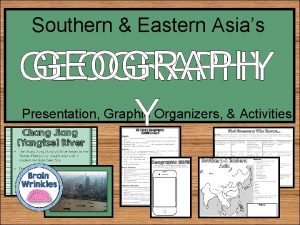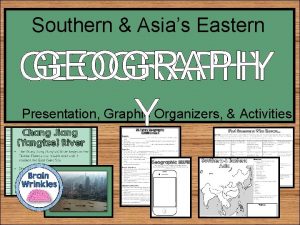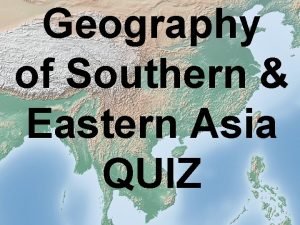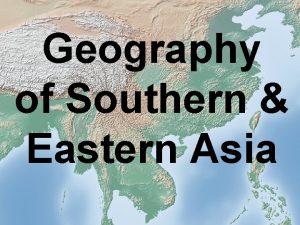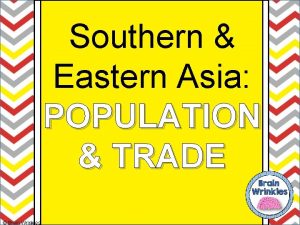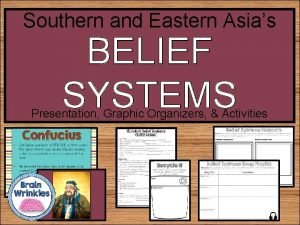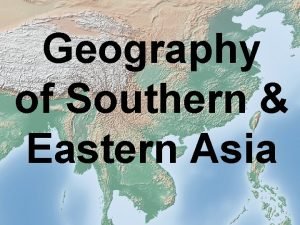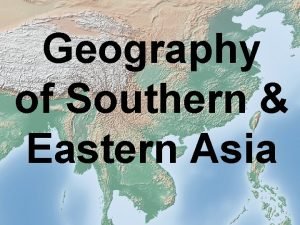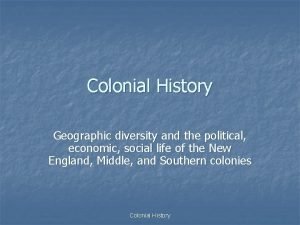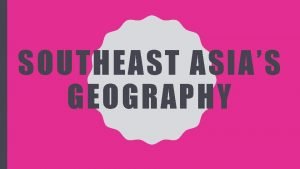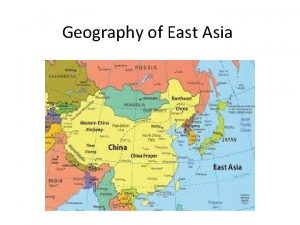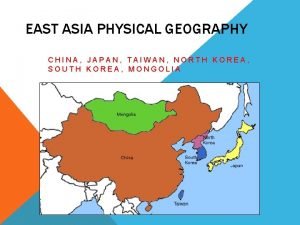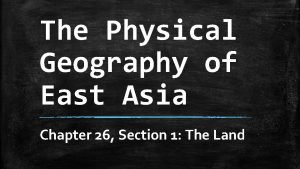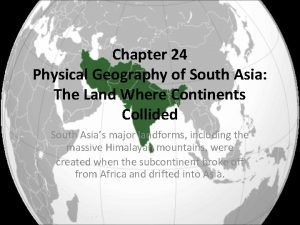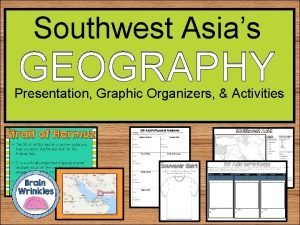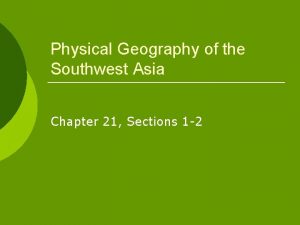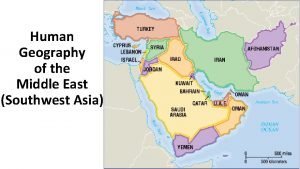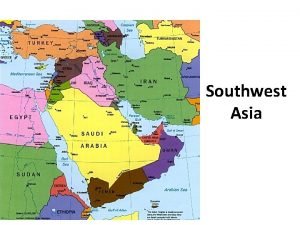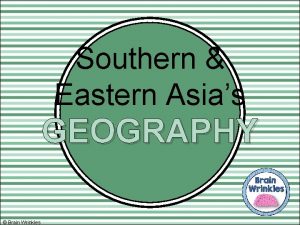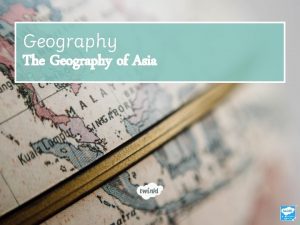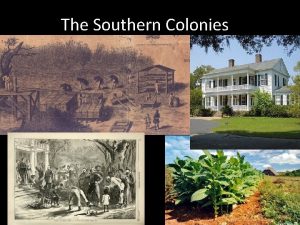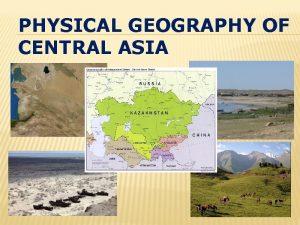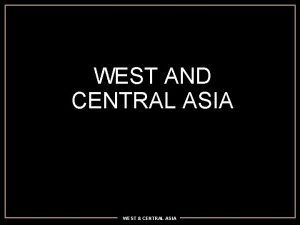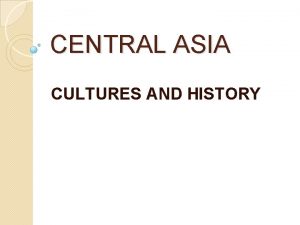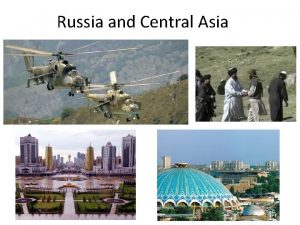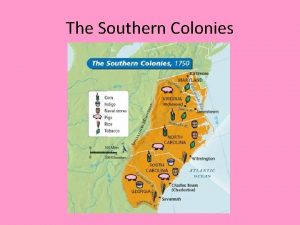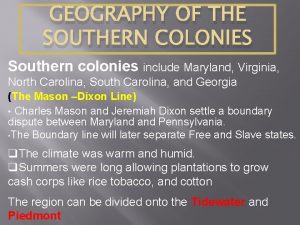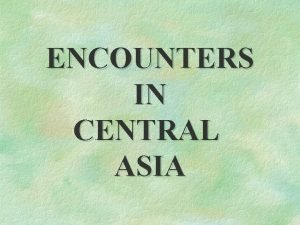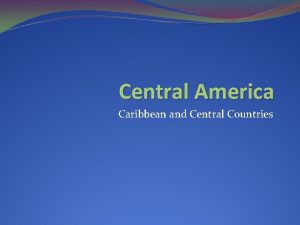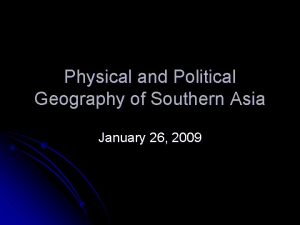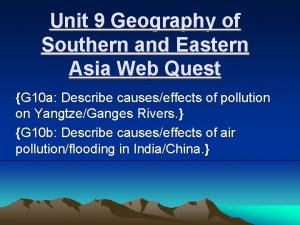Central and Southern Asia Geography of Central Asia

























- Slides: 25

Central and Southern Asia

Geography of Central Asia • Arid grasslands (steppe) • Crossed by horses but too dry for agriculture http: //travel. nationalgeographi c. com/places/region_c entralasia. html

Lifestyle • Nomadic herders, who relocated twice a year • Social and political organization based on family: clans, tribes, tribal confederations • When resources were in dispute, tribal fighting ensued; no central authority to resolve disputes • Trade or raiding to get objects from settled communities • Leadership based on military skill, sometimes charisma

Turks • Shamanistic, heavenworshiping religion • First people of inner Asia to record their own language • 552 they began to build empire, which extended from Central Asia to Mongolia Kyrgystan image from http: //travel. nationalgeographic. c om/places/countries/country_kyr gyzstan. html

Turk Empires • When Turks took control of central Asia, the Sogdians (Persian-speaking) persuaded them to make contact with Persian and Byzantine courts • 576 Turks captured Byzantine city of Bosporus • Turks in East (Mongolia) raided into China (Tang Dynasty)

Uighurs • • • 8 th Century Turks in Mongolia Adopted religions along the Silk Road Lasted one century Destroyed by the Kyrgyz Fled to western China, established capital at Kucha (Contemporary link on Kucha: http: //www. npr. org/templates/story. p hp? story. Id=93565617)

Turks in Western Asia • Turks were incorporated into Abbasid armies • Tenth century Turks began converting to Islam • 1055 the Abbasid caliph recognized Tughril Beg as sultan • Turkish confederations extended into Asia Minor, Afghanistan, and northern India

Turkish culture • East: a blend of Turkish tradition and cultural influence adopted from Silk Road • West: traditional Turkish elements, influenced by Sogdians, and Islamic culture influenced by Persians (Persian tended to be administrative and literary language; Arabic used for religion; Turkish languages used in vernacular)

Mongols • Khitans and Jurchens formed hybric nomadic states (north lived traditionally, south blended with Chinese settled communities) • Had their language recorded; adopted Chinese governing practices; became culturally dual National Geographic on Mongolia: http: //travel. nationalgeographic. com/ places/countries/country_mongolia. ht ml

Mongolian daily life • • • Herding Yurts easily transported Food: animal products; fuel: dung or grass Clothing: furs and skins because of intense cold Women: drove carts, set up yurts, herded animals, did the milking, prepared felt/clothing (no water used for washing); expert riders and shooters • Men: constructed equipment; broke horses

Social organization • Kinship basis • Could not marry within clan—raided for wives • Women inherited by male relatives • Captured men enslaved, but not necessarily for life • Constantly on defense against raids • Boys learned to use compound bow

Chinggis Khan • Death of father left Chinggis Khan vulnerable; sought revenge • Personal courage in battle and generosity to followers • 1206 recognized as the Great Khan • Ordered Mongol to be written down, including record of Mongol laws • United tribes of Mongolia; fighting turned on settled communities

Pattern of conquest • Attack and conquer a city, then send demands to neighboring cities to surrender or suffer the same • Those who submitted could become allies • Those who resisted faced mass slaughter • Example of attack on Shah of Persia in 1218

Succession • Division into four khanates • 1237 Invasion of Europe: conquered Moscow, Kievan Russia, looted cities in Poland Hungary • Only death of Great Khan, Ogodei, in 1241 turned them back from further west invasions • Refocused on Persia and Middle East • Destroyed the last Abbasid caliph • Resisted by Delhi sultanate and Mamluks in Egypt

Khubilai Khan • Completed conquest of Korea (1258) and China (Song Dynasty) • Mongols became experts in naval warfare • From 1274 -1281 attempted to invade Japan, but turned back in second attempt by kamikaze or “divine wind” (fierce storm) • 1293 failed attempt in Southeast Asia

Reasons for Success • Superb horsemen and archers (mobile and accurate) • Open to new technologies and fighting techniques (adaptable) • New organizational structure (loyalty) • Use of intelligence information (knowledge) • Good rulers because they incorporated other ethnic groups into armies and government • Tax-farming

India: Gupta Empire • Modeled after Mauryan empire • Chandragupta was founder • United North India, alliances with states in Nepal and Indus Valley • Chandragupta II defeated Shakas in West India and took control of trade between Middle East and China

Characteristics of Gupta • Taxed ¼ of harvest • Demanded labor for work on roads, infrastructure • Maintained monopolies on key products like metal and salt • Patrons of the arts • Rise of Indian drama (India’s greatest poet, Kalisada) • Achievements in math: Arabic numerals

India Medieval Age • India broke up into four major regions • Cholas dominated southern tip and Sri Lanka • Political division fostered local cultures

India and Islam • 711 Pirates plundered an Arabic ship; Umayyad governor sent force in retaliation • Western part of India was conquered and maintained as part of caliphate • Ninth and 10 th centuries, Turks occupied Central Asia and Afghanistan

Mahmud of Ghazni • 997 Mahmud (Turkish ruler from Afghanistan) sent raiding forces into India every year for 17 years • Looted Indian palaces and temples: Why? What would have been his justification? • Turkish raiders killed 50, 000 Hindus • Eventually Turks even conquered the Sind (western area that had been controlled by Umayyads)

Cultural Contact • How did the caste system affect the prospects of Hindu conversion to Islam? • Over time, Hindus became a protected class, but Buddhists were persecuted by Muslims. Why?

Muhammad of Ghur • New Turkish leader in Afghanistan who captured Delhi • Established Sultanate of Delhi that lasted over 300 years • This Sultanate successfully held off Mongol invasion of Northern India (secret weapon was elephants) • Sultanate went into decline in 14 th century, defeated by Tamerlane

Southeast Asia • • Funan: Located in southern Vietnam Controlled Indochina and Malay Peninsula Controlled Trade at the Isthmus of Kra 939 Vietnamese became independent of China • Thais: (sw China and Burma) United in confederacy in 8 th century • Thais fell to Mongols in 1253

Southeast Asia continued • Burma: Established in 8 th century with capital at Pagan • Khmer Empire of Cambodia: 802 founded, peaked in 1219 • Srivijaya: maritime empire that controlled Strait of Malacca • Based on island of Sumatra • Links to Indian traditions, culture
 Sw asia geography cloze notes 1
Sw asia geography cloze notes 1 Brain wrinkles southern and eastern asia
Brain wrinkles southern and eastern asia Southern and eastern asia physical features answer key
Southern and eastern asia physical features answer key Southern & eastern asia physical features map answer key
Southern & eastern asia physical features map answer key Brain wrinkles southern and eastern asia
Brain wrinkles southern and eastern asia Brain wrinkles southern and eastern asia
Brain wrinkles southern and eastern asia Se asia's belief systems cloze notes
Se asia's belief systems cloze notes Physical features of southern and eastern asia
Physical features of southern and eastern asia Southern and eastern asia physical features
Southern and eastern asia physical features Southern colonies geography
Southern colonies geography Kums definition geography
Kums definition geography Swana political map
Swana political map Map of asia countries
Map of asia countries East asia physical geography
East asia physical geography Taiwan physical geography
Taiwan physical geography Vocabulary activity 24 cultural geography of south asia
Vocabulary activity 24 cultural geography of south asia Chapter 27 section 1 landforms and resources
Chapter 27 section 1 landforms and resources Chapter 22 human geography of southwest asia
Chapter 22 human geography of southwest asia Lesson 1 physical geography of southeast asia
Lesson 1 physical geography of southeast asia Physical geography of east asia
Physical geography of east asia Climate zones of asia
Climate zones of asia Brain wrinkles southwest asia
Brain wrinkles southwest asia Map of southwest asia
Map of southwest asia Human geography of the middle east
Human geography of the middle east Chapter 21 physical geography of southwest asia
Chapter 21 physical geography of southwest asia Chapter 25 human geography of south asia
Chapter 25 human geography of south asia
